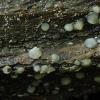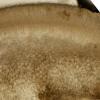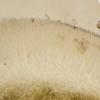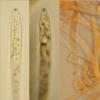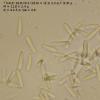
31-12-2025 19:27
Collected from loamy soil, at waterside (completel

30-12-2025 16:44
Pascal DucosBonjour,Une anamorphe rose stipitée, très nombre

30-12-2025 17:14
 Bernard CLESSE
Bernard CLESSE
Bonjour à toutes et tous,Pourriez-vous aider Albe

29-12-2025 10:15
Hulda Caroline HolteHello, I found and collected this propoloid ascom

30-12-2025 09:04
Hello.A Pyrenomycete sprouting sparsely but very d

29-12-2025 17:44
Isabelle CharissouBonjour,J'aimerais savoir si d'autres personnes au

12-11-2021 00:03
Lepista ZacariasHi everybody,A week ago in my fiels trip I noticed
Mollisia cf rivularis
Viktorie Halasu,
22-06-2017 18:45
 Hello,
Hello, there's another Mollisia from the same stream, close to M. rivularis, but without LBs.
On water-soaked wood in a brook between spruce and beech forests, 620 m a.s.l. Apothecia cca 2 mm in diam., solitary or in groups.
Spores sometimes heteropolar, OCI=0.
Asci IKI+ bb, croziers+
Marginal cells short, brownish.
Medullary exc. = t. intricata, running mostly parallel to the surface, hyaline, no crystals.
Ectal exc. = t. angularis turned 90° to the surface, brown cell walls.
KOH negative
I couldn't get a good look on the paraphyses, I just assume that there are those long VBs.
Should I name it "cf rivularis", or is there a better name for this collection?
Thank you for any advice.
Viktorie
Hans-Otto Baral,
22-06-2017 20:28

Re : Mollisia cf rivularis
I do not know well M. rivularis but the fungus by Joaquin seems to be similar.
Viktorie Halasu,
22-06-2017 21:34

Re : Mollisia cf rivularis
Andreas wrote somewhere here that rivularis should have OCI=1. Also Piotr Perz's collection in the database here has some small LBs. Also the spores of my collection are longer, there's only * 9-12(13) um in the key.
Andreas wrote here that there are some intermediate collections between rivularis and uda/pulviniformis, so I wasn't sure if this is not one of them too.
Andreas wrote here that there are some intermediate collections between rivularis and uda/pulviniformis, so I wasn't sure if this is not one of them too.
Hans-Otto Baral,
22-06-2017 22:17

Re : Mollisia cf rivularis
In any case interesting. I fear with Mollisia one has to do molecular work together with detailed morphology.



